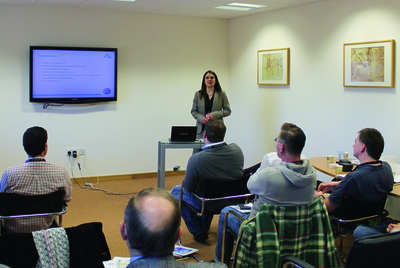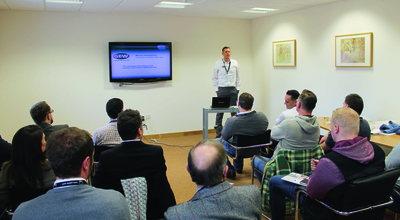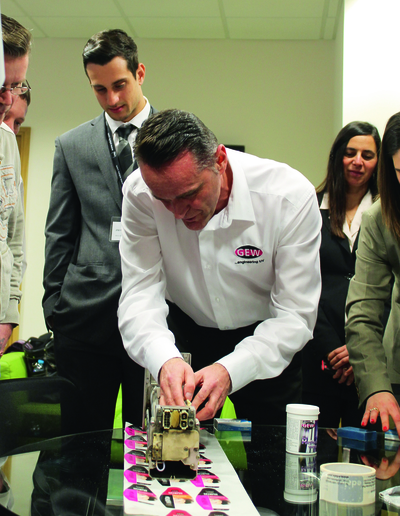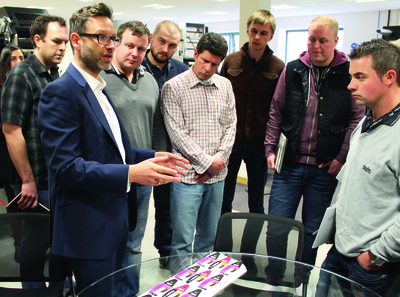James Whitehead explaining the various types of tests available for checking your print has cured correctly
Maintenance of UV lamps and systems was the focus of the second training day held by BPIF labels and it proved a very popular topic. Held at press manufacturer Edale’s premises near Portsmouth, the sell out day saw presentations from various manufacturers and hands on demonstrations in the company’s showroom. Neel Madsen went along to learn more.
The one day course on the care, maintenance and use of UV lamps and systems for flexographic printing organised by BPIF labels was held on 5 March. The comprehensive programme consisted of presentations from Alpha-Cure Ltd, GEW (EC) Ltd and Fujifilm, followed by practical training and demonstrations in Edale’s showroom where a brand new FL-3 label printing press was running print trials.
Anatomy of a lamp
Alpha-Cure Ltd manufactures UV lamps and boasts a product range of some 10,000 different lamps for all types of applications, including printing, bonding, coating and disinfection. The Northamptonshire-based company has partnerships with 45 OEMs worldwide, and a second sales and manufacturing facility in China, which was opened in 2005. Sales of lamps total 147,000 individual units per annum.
The anatomy of a UV lamp, and the different types and sizes of lamps were described in great detail by commercial director, Victoria Atherstone, giving the delegates a better understanding of exactly how UV curing works and why it is so important to operate the systems in the correct way and keep on top of maintenance.
Handing round several examples of used lamps for inspection, she went through the list of reasons why a lamp might fail and how this can be avoided through the proper care and usage. The troubleshooting guide presented on the day is also available on the company’s website along with a technical glossary and tips on how to prolong the life of lamps.
 Alpha-Cure’s Victoria Atherstone gave a presentation on the design and function of UV lamps
Alpha-Cure’s Victoria Atherstone gave a presentation on the design and function of UV lamps
Keep it clean
‘How many of you have a regular maintenance programme in place?’ was one of the questions from GEW (EC) Ltd’s international sales manager, Marcus Greenbrook, to the participants. The response was not overwhelming, and although everyone was well aware of the importance of keeping the UV lamps clean to maximise their curing capabilities and ensure high quality print, the feedback was that it is difficult to find enough downtime to do so.
His presentation on the changing technology of UV systems and current developments highlighted how modern systems are now so efficient that they do not need to be run at full power for all jobs and can save up to 46% in energy costs without any compromise on productivity. For lower printing speeds, curing can be done at 90 W/cm, while higher speeds require up to 140 W/cm. These newer low energy systems are also much simpler to clean and maintain, as cassette designs give easy access and require little or no tooling to remove and replace.
If correctly cared for, modern UV lamps can last up to 4,000 to 6,000 hours, but this requires a rigorous maintenance programme to prevent degradation in the curing process, but as Mr Greenbrook said, ‘Most often, the only reason a cassette is pulled out is to change the lamp not to clean the system.’ This was echoed by a printer who said that it is much quicker to simply replace all the lamps rather than finding time to clean each curing unit on the press. This of course is a false economy and is likely to cause a number of problems with the printed product.
 Marcus Greenbrook reminded printers that UV systems do not need to be run at full power for all jobs
Marcus Greenbrook reminded printers that UV systems do not need to be run at full power for all jobs
GEW also offers a UV LED system and there was some debate between the participants as to the merit of this technology. Mr Greenbrook stated that at present UV LED systems are slightly more expensive overall, but that costs are likely to come down rapidly over the next few years.
Thumb twist
How to achieve effective curing of UV inks was the topic of James Whitehead’s presentation. As product manager at Fujifilm Graphic Systems, he visits a lot of printer customers and knows first hand the problems and challenges they face.
Mr Whitehead described how it is the photoinitators in the ink that causes monomer and oligomers to react together during exposure to UV light, thereby creating the ink film. He then went through the issues that can cause problems in curing, how they manifest themselves and the action to be taken to correct the problems. Insufficient light, poor ink reactivity and poor through cure can cause the ink to remain soft and tacky or scratch off easily, which in some cases can be confused with poor adhesion. Common techniques for testing adhesion and effective curing include the reticulation test, fingernail scratch, thumb twist and tape test. Later in the day, these tests were tried and debated during the live print trials.
Hands on
The interactive element of the day during the afternoon gave participants a chance to get up close and personal with GEW’s UV curing systems that were mounted on the new Edale FL-3 press installed at the showroom just days earlier. Pulling freshly printed labels from the press, Mr Whitehead demonstrated the theory from the morning session and let participants try the various test methods for themselves.
Chris Nuttall, GEW’s UK sales manager, who also gave a presentation on preventative maintenance, showed how simple it is to clean the various parts of the system. He said, ‘Generally maintenance is a reactive thing rather than a preventative measure, but it is important to re-educate yourself to understand how prevention can save your company time and money in the long run. You need to protect your print runs.’
Mr Nuttall listed the values of planned maintenance as improved system reliability, decreased cost of replacement parts, improved profitability, improved staff moral due to presses producing high quality print (‘nobody wants to come to work to run a failing press’), and better time management. The cleaning regime should include weekly checks on air regulation, cabinet filters, flexible ducting and earth leakage. Lamphead maintenance every 500 hours should include cleaning of the lamp, quarts filter, reflectors and the housing itself. The company offers a health check service carried out by one of their specialist engineers.
 Chris Nuttall demonstrated the correct method of cleaning of the reflectors in a UV curing system
Chris Nuttall demonstrated the correct method of cleaning of the reflectors in a UV curing system
More to come
The feedback from the participants was positive, and the format of the day worked very well, giving everyone a chance to discuss how their company deals with curing problems and to ask specific questions. The next training day on die-cutting will be held at RotoMetrics UK facility in Alridge, while there are plans to cover press finger printing, ink usage and returns, and plate mounting at future events.
Edale is holding its own training day on 17 June entitled, ‘Improving your print quality’, together with supporting partners Creation Reprographics, Cheshire Anilox Technology, Fujifilm and Lohmann.






